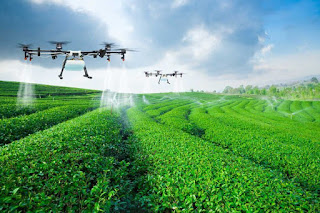Reforming agriculture using AI – Smart Farming
AI is the buzz word these days for the unthinkable innovations
that it is bringing for different industries like healthcare, automobile, image
processing, etc. The world is changing with AI and the agriculture industry is
gaining on. The way agriculture is practiced today and the way it was practiced
100 years back has a prominent difference. So, yes, AI is setting its step in
the agriculture industry as well.
Drones, automated tractors, satellite imaging, robotic harvesting,
and precision farming are and will be used to improve the yield, cost and other
key factors of the agriculture industry. IoT sensors and automated farming
tools can measure soil moisture, irrigation while drones can monitor the
quality of the crops to improve the agriculture business.
This digital smart farming is referred to by worldwide
experts as agriculture
4.0. These digital farms will be much more efficient and sustainable
compared to conventional farms. The
world population is expected to rise to 9.1 billion by 2050 and hence, we need
advanced technologies to ensure swift go-to-the-market crops.
Satellite Imaging:
 |
| Image source: squarespace-cdn.com |
Using drones in agriculture farms will help in monitoring
crop growth and in-turn production. Drones can monitor each stage of production
and help farmers take data-based decisions. They can help farmers get an aerial
view of their farms. This bird-eye view will bring out issues related to
irrigation, soil change, pest or fungal incursion.
By identifying the problematic factors, a farmer can take
preventive actions and improve the yield. They will not need to walk on the
farm and inspect each plant individually. It will rather give farmers time to
concentrate on the big picture of production and management.
Before farming commences on a farm, using drones, the farm
can be inspected for its health. For the crop to be planted, the drones can give
an aerial view of the farm before seed sowing instead of facing a loss in the future
due to failure of crop or less growth.
Self-driven automated
tractors:
 |
| Image source: marketresearchbiz |
Just like driverless cars, driverless self-driven tractors
don’t need a human to drive. They are programmed in a way that they can move precisely
without any intervention. They can detect humans, animals or any other obstacle
coming in their path and act accordingly.
They can tilt a farm just like a normal tractor and sow
seeds. They can monitor their speed, position, and other factors while performing
their task. They operate using a remote control or a supervisor monitoring in a
control station.
They can reduce the time and efforts spent on on-farm
activities and create a safer and fast way of farming thus, relieving the
stress of farmers.
Analytics-based
precision farming:
 |
| Image source: i2.wp |
Technology like crop modeling can be used to implement
precision farming; by using sensors a crop model can be created. A farmer has
to simply wire information like soil type, the quantity of fertilizer used, and
the day of seed sowing. The application will model the crop and provide the
farmer when to expect which stage of the crop, quantity of the yield, and
quality of the yield.
Farmers can plant such sensors in the farm and get the
expected yield information. Depending on the result of the application they can
plan ways to improve the crop’s quality. They will not need to inspect the
crops daily and manually for the growth.
Robotic harvesting:
 |
| Image source: bangkokpost |
Robotic harvesting machines are been created by companies to
not just overcome the labor gaps but also to speed up the harvesting process.
These machines can pluck ripe strawberries or pluck apples from trees. The
manufacturing robots are common but harvesting robots are something new and
exciting in many ways.
These machines operate on machine vision and sensor fusion
to figure out where the harvest is and pluck it from there; they have precise
sophisticated ways for harvesting. Also, it will mimic human cognition and
action. A farmer won’t have to take efforts in cutting each harvest and storing
it without spoiling it.
Fewer efforts, more
yield and reduced cost for farmers
Every year farmers loose portion of their yield because they
can’t predict the quality or quantity of their crops. With such technologies,
they will have to put less effort and monitor the condition of crops daily to improve
their crops. Technology can helps farmers generate the revenue that they
deserve for the efforts they put in growing a crop.

Comments
Post a Comment